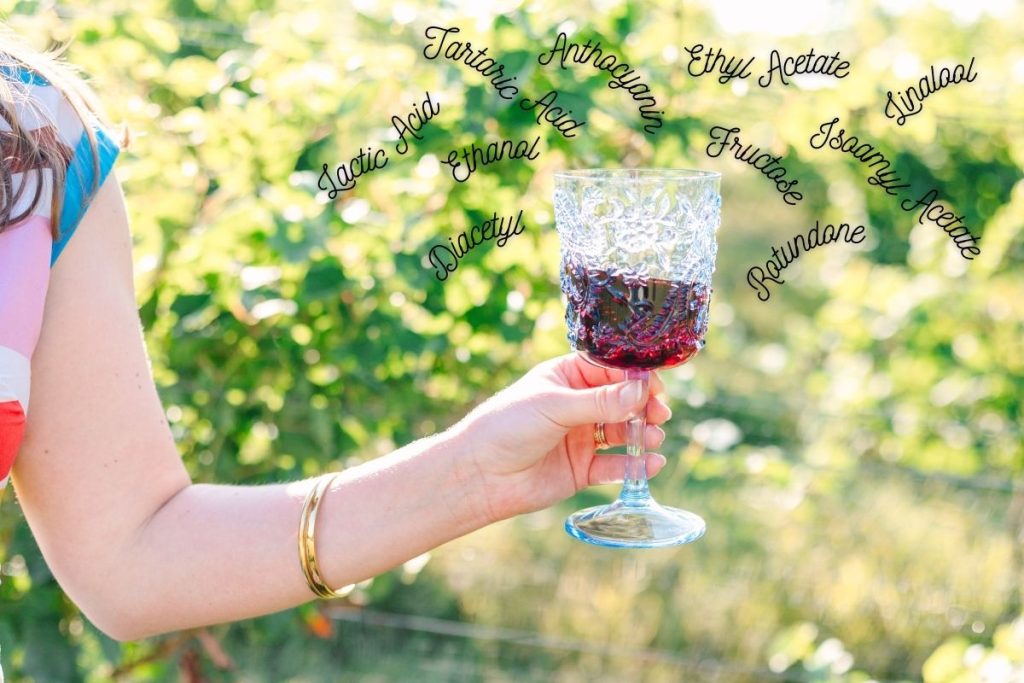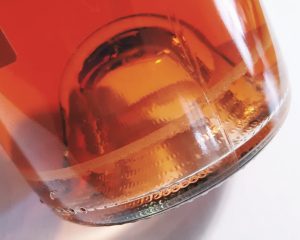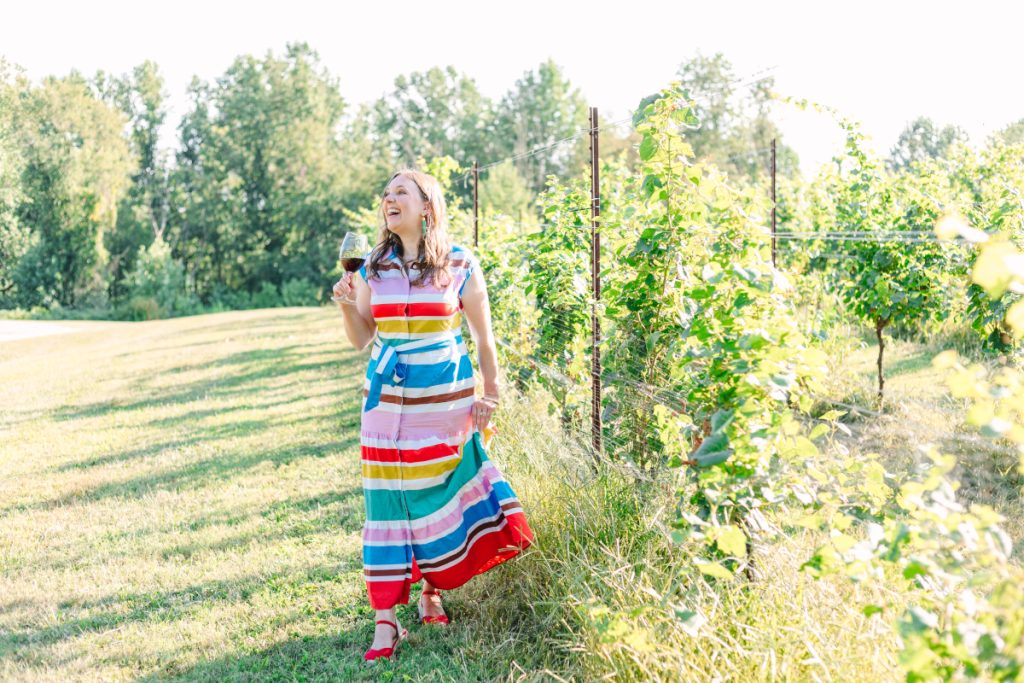
Photo by: Savannah Smith Photography, edited by Denise M. Gardner with permission
Have you ever wondered what is actually in your glass?
If so, you aren’t alone.
In a world where terms like “Franken-Wine” or “Natural Wine” or “Organic Wine” are thrown around regularly, it can be pretty daunting for wine drinkers to actually know what is in the bottle.
Let’s dissect what a grape wine actually is: breaking it down component by component!
The Major Components of Wine
Water
The majority of wine is actually water. That’s right! Water – a whole lot of H-2-O (the chemical formula for water). The concentration of water varies based on the alcohol concentration of the wine. Therefore, lower alcohol wines contain more water, and higher alcohol wines contain a little less water.
Alcohol
Only 7 to ~15% of wine is ethanol, the primary alcohol that makes up wine. In fact, by definition, wine has to be at least 7% alcohol.
For most food and beverages, grape wine (and other wines!) included, definitions for what makes those products what they are, are found in the Code of Federal Regulations, or CFR. First published in 1938, the CFR codifies rules that are subject to Federal Regulation. There are 50 titles within the CFR that represent broad subject areas, and “wine” falls under Title 27: Alcohol, Tobacco Products and Firearms. With 27 CFR are paragraphs of information that standardize and define what wine is, how it can be produced, and how it can be labeled. Thus, based on the Standard of Identity within the CFR for wine, a “wine” always has to be at or above 7% alcohol. Anything below this alcohol concentration cannot get labeled as “wine.”
While this may seem confusing, or even arduous, the reality is, is that the CFR protects consumers like you and me. These definitions ensure that no matter where you purchase a wine within the U.S., you are guaranteed that it adheres to these definitions. This inhibits producers from, say, diluting wine with a lot of extra water and still call it wine!
Want to see more about the CFR? An unofficial version is available online, here (this portion is related to wine).
The Minor, but Significant, Components
Acid
The primary acid in grapes is tartaric acid. Tartaric acid is somewhat unique to grapes! Hence, the primary acid in wine is also tartaric acid.
In wine, tartaric acid has a unique property associated with its dominance in wine. When in contact with potassium (which is usually prevalent in wine), the two can connect, or bind, and create potassium-tartrate crystals. These crystals can appear in white wines as clear or white, small or large, and can appear in red wine as small and dark purple.
Wine Lovers do not have to worry about potassium-tartrate crystals. They are harmless. In fact, potassium-tartrate is the primary ingredient of cream of tartar. This sour-tasting ingredient is regularly used in the baking, which stabilizes egg whites in meringues or prevents sugar crystallization in caramels. It may also get used in sourdough bread making to provide, well, some of the sourness.

Photo by: Denise M. Gardner
Several other acids exist in wine. Grapes also naturally contain malic acid, which is the primary acid in apples. During fermentation citric acid, acetic acid, and succinic acid are developed. Citric acid is the primary acid in citrus fruits while acetic acid is the main acid associated with vinegar. Fermentation and malolactic fermentation, a second acid-based fermentation applied to many red wines and Chardonnay, also creates lactic acid. Lactic acid is the primary acid in milk. It may be surprising, but individually, each of these acids can have a unique taste association.
The point of this is simply to say: there’s a lot of different acids in wines! The combination of all of these acids in various proportions greatly influences wine stability, color, and flavor.
Sugar
During fermentation, a special type of yeast converts the sugar from the grapes into ethanol and carbon dioxide gas. In theory, fermentation progresses until there is no more sugar left or until the alcohol concentration is too high for the yeast to continue converting sugar into ethanol.
In reality, many wines range in residual sugar: the sugar left over from fermentation. This can be due to:
- seasonal variation in starting sugar prior to the start of fermentation,
- struggles by the yeast during fermentation, or
- intentional “arresting” of the fermentation by the winemaker.
In this last option, the winemaker makes the fermentation conditions so undesirable for the yeast that they stop being able to continue the fermentation process even if a fair amount of sugar remains in the wine.
In addition, winemakers can “add back” sugar in the form of granular sugar (sucrose, which breaks into glucose/dextrose and fructose in equal concentrations once dissolved in wine) or with the addition of grape concentrate. When adding back sugar, winemakers allow a wine to ferment to dryness, which is when all of the sugar is depleted for alcohol fermentation. Near the end of processing, sugar is dissolved and added back into the wine. Winemakers may want to do this to ensure stability of the wine through its production entirety or ensure a certain alcohol concentration for the wine. This latter option is because winemakers cannot add extra ethanol to a wine without the wine getting classified as a different product. (This has to do with the definitions outlined in the CFR.)
Later on in the winemaking process, after the wine has been stabilized and clarified, sugar is added in the form of granular sugar or grape concentrate prior to the wine’s bottling. With these wines, the winemaker has more control, and more consistency, in terms of how much sugar goes into the wine. The bulk of sweet wines produced in the U.S. are made this way.
I think it’s important for readers to be aware that sometimes wines may be listed as “dry,” but still contain about 1% sugar (equal to about 10 g/L of sugar). Many International Red Wine style wines may fall in this category. Several California Chardonnays often fall into this category. However, the wines are still considered dry because many Wine Lovers may not be able to identify the wine as tasting “sweet.”
Tannins or Phenolics
An important component of wine grapes includes the phenolic or tannin/tannic content. Phenolics are found in the grape skins and grape seeds. Different classes or groups of tannins/phenolics may occur in these different parts of the grape. These tannins are then extracted into the wine during the fermentation process.
Red, white, and rosé wines all contain some sort of tannin content. Though, the concentration of phenolics/tannin and the types of phenolics/tannin will vary based on wine color, the region in which grapes were grown, variety, and growing season influences.
The red color in red wines, in fact, are a group of phenolics called anthocyanins. Anthocyanins are the red colored pigments in grapes and wine, but they are also found in other fruits and vegetables. Their concentration and color hue will vary based on wine grape variety, the region in which grapes were grown, the growing season, and winemaking operation decisions. Pinot Noir, for example, is notoriously low in anthocyanin concentration compared to other European wine grape varieties (like Cabernet Sauvignon or Malbec), which can make Pinot Noir wines lighter in color intensity. This does not make Pinot Noir bad, but it does have a direct reflection on the color intensity, which may confuse wine drinkers used to drinking darker colored red wines.
Furthermore, wines grown in the Midwest and Eastern U.S. often contain lower concentrations of tannins compared to grapes grown in the Western U.S. For many hybrid wine grape variety wines, like Chambourcin, this can make the wines taste softer or juicier. This is because many red hybrid wine grape varieties have a reduced tannin concentration that influences the mouthfeel and taste of wine. If you are someone who enjoys lighter bodied, juicier, or less astringent (tannic) wines, then many red hybrid variety wines offer some good options for you.
Flavor
Flavor components make up less than 0.001% of wine’s total composition (Waterhouse, Sacks, and Jeffery, 2016), but it is also some of the most impactful parts of wine. The flavor components are what make wines identifiable by variety and region. It’s what makes a Cabernet Sauvignon different than a Merlot. A Riesling different than a Chardonnay.
And often, flavor and the combination therein, is what is heavily discussed by wine experts. The flavor is what ultimately leads to those fancy wine descriptions you see in wine stores or online retailers. It’s funny that something found in such small concentrations ends up being quite impactful for wine.
Flavor components may sound scary: isoamyl acetate, ethlyl acetate, geraniol, beta-damascenone, diacetyl, linalool, rotundone, vanillin, furfural, isobutylmethoxypryazine (IBMP), eugenol, acetaldehyde…. And many more! But these are the chemical names for the various components that make up the flavor and smell of the wine.
Flavors are broken into three groups based on where the component originates:
- Flavors provided by the grapes. In many white wines, aroma components like geraniol (rose, geranium) and linalool (floral, lavender) are common. Riesling, in some instances, can contain a component called TDN, which provides the petrol character. Some reds will contain other components like rotundone (black pepper) in Syrah or Noiret or eucalyptol (eucalyptus) in Syrah. The group of components called methoxypyrazines, including IBMP, smell and taste like green bell peppers. These components are very common in wine grape varieties like Sauvignon Blanc, Cabernet Sauvignon, and Cabernet Franc.
- Flavors developed through fermentation and, potentially, malolactic fermentation (known as MLF, a second fermentation in red wines and some styles of Chardonnay). Fermentation is the main source of many aroma and flavor components in wine. And most of these smells and flavors are created by the yeast. This is going to include a lot of esters like isoamyl acetate (banana) and ethyl acetate (cherry, pineapple, or even a nail polish aroma in high concentrations) in all wines. Diacetyl (butter or butterscotch) is primarily produced through MLF.
- Flavors extracted from yeast and/or barrels during aging processes. This is often referred to as the “bouquet.” This is going to be something like vanillin (vanilla) or furfural (sweet, caramel-like, almond, bread).
The flavors provided by the grapes and fermentation are often identified by certain chemicals and the flavors provided by the oak are identified by completed different chemicals. For example, the component called “wine lactone” (coconut, spice) is exclusively from oak extraction during aging.
One of the most fascinating parts about wine flavor is that it is difficult to recreate using individual flavor components. The sum of all of the different flavor chemicals creates these unique, identifiable smells/aromas and flavors that many of us have come to love!
And Now You Know!
Wine, like many other beverages (i.e., coffee, tea, and even orange juice), is a complex beverage made of component parts: water, alcohol, acid, sugar, tannin, and flavor. There are a few other components in there like proteins, polysaccharides, ions, mannoproteins, and more… but the ones covered here today are the major ones.
While many of these components may sound scary, it’s simply the different parts that make up wine!
Ultimately, it’s this science that give winemakers a strong understanding of how wine will taste. Then, wine writers use that information to interpret how strong something like the alcohol or acidity is perceived when it’s tasted. They also do this with flavor, which is where all of the fanciful descriptions come from in their descriptions. They use their sensory skills to try to write into words what you can expect to taste. Does it always work? Are the descriptions they use always helpful? No. That is certainly an issue that many wine writers have in communicating the taste of wine to Wine Lovers like you and me. But at least now, you know what they are trying to describe.

Photo by: Savannah Smith Photography
This post was written and supported by the following resources:
Flavor descriptors primarily sourced from Flavornet: https://www.flavornet.org/flavornet.html
Waterhouse, A.L, G.L Sacks, and D.W. Jeffery. 2016. Understanding Wine Chemistry. ISBN: 978-1-118-62780-8.

